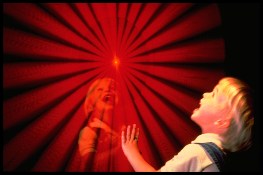| down a just built, teetery structure of blocks is a fine example of an order-disorder transition? Why do we admire children when they build a pattern of objects with great symmetry, but then refuse to understand that when they "ruin" it with a misplaced object, they, in fact, have made an aesthetic decision? | and economic decision making. It is, therefore, also not surprising that art instruction is the first to go when school budgets get tight. Aesthetic considerations and what artists have taught us about human experience are invariably the first to be ignored when we design and build housing developments, supermarkets, barren freeways, topless dance joints, nuclear weapons, and homes for the aged. A possible step in a new direction. It will be a while before we can do much about housing developments, shopping centers, and nuclear weapons. But how about beginning with children's toys, and, incidentally, with school teaching materials. Contemporary toys are aesthetically abominable, even when their pedagogy has been creatively conceived. It is true that many of them have wonderful, bright colors and even pretty pictures. But they do not feel nice. They do not come apart and go together neatly. It is impossible to modify them, to use them alone, or in combination in outrageous contexts. One cannot step on them or throw them - and anyway, they do not make a nice sound when they hit the floor. I remember that in 1917, when I was five, I "sank submarines" by hurling a large, marvelously built and balanced screwdriver along the floor to make gaping holes in tin cans. And later, what an exciting thing it was to have a clock spring burst out of its toothed brass container and then to take the time to carefully coil the flat blue steel back into its tight spiral within the brass. The learning and pleasure of play involves using the props of society, often the finer ones, divorced from the context of their original purpose. If really good toys are too expensive, then toy stores should get around the difficulty by refusing to buy from toy manufacturers and instead stock a carefully selected collection of commercial, industrial, and military surplus items and materials. Even contemporary tricycles, the brightly colored plastic ones, tilted up in front and with small, fat rear wheels, are extraordinarily unpleasant, compared to ones with metal frames, wire-spoked wheels, and bearings that need to be oiled once in a while. | |||
 | ||||
| We could be cued into the aesthetic sensibility of even very small children by the intense pleasure they express when, for example, the lids to little boxes fit precisely and smoothly. I was alerted to these sensibilities a few years ago when a four-year-old girl uttered a shriek of delight after watching a rather spectacular disorder-to-order transition. At the end of the day, at a lake in Golden Gate Park, a boatman had to remove all the public row boats from the docks and move them for the night under a shed in the middle of a lake. He started by untying them from the dock and tying them together in an impossible looking, random mess of every which way boats. The four-year-old looked on with increasing anxiety. Finally, the boatman attached his puttputt to one of the boats and took off. The fifty or so boats broke out of their tangled web and followed him in two lines that formed a beautifully curved symmetric "V." It was at that point that the four-year-old burst forth with her shriek of aesthetic delight. Where it ends. Our unwillingness to recognize and nurture the role of aesthetic choice, decision making, and satisfaction in very young children is not really surprising. It is symptomatic of attitudes that pervade our entire process of social, political, | ||||